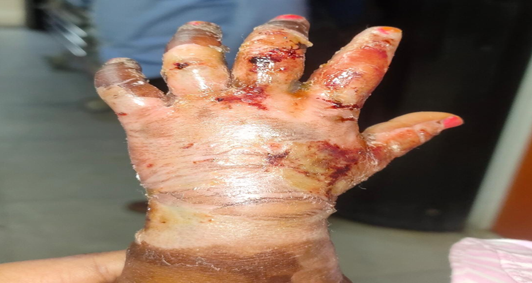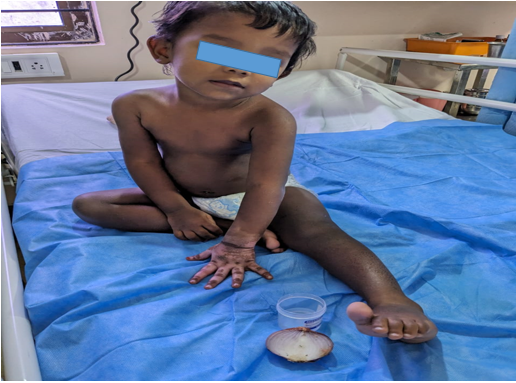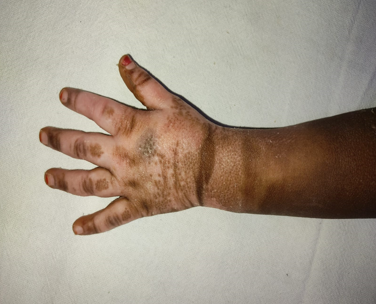- Visibility 106 Views
- Downloads 11 Downloads
- DOI 10.18231/j.jsas.2023.024
-
CrossMark
- Citation
Role of onion extract in preventing abnormal scarring in scald injury
- Author Details:
-
Kumaravel
-
Ravi Kumar Chittoria *
-
Bharath Prakash
Introduction
For doctors, abnormal scars like keloid and hypertrophic scars continue to be a difficult issue.[1] Scarring is influenced by both physical and emotional factors. They may also result in severe functional and aesthetically unpleasant issues.[2] Typically, hypertrophic scars result in itching and pain, which lower one's quality of life. Depending on a person's unique circumstances, including heredity, the type of wound, and infection, the expense of treating these scars may also be high. Scar prevention is an intriguing alternative in scar treatment because scar treatment typically lasts 6 months to 1–2 years on average.
According to reports, onion extract possesses anti-inflammatory, antibacterial, anti-proliferative, and regenerative properties.[3] This gel is well accepted, aids in preventing pathological scars, and both treats and heals existing scars, according to numerous clinical trials. Numerous scar care solutions contain quercetin, a substance obtained from onion extract. It contains bacteriostatic, anti-inflammatory, and collagen-reducing properties.[4] Hypertrophic scarring can be reduced by using semi-liquid onion extract topically. In this article, we discuss our experiences using an anti-burn gel made from onion extract as a preventative measure.
Materials and Methods
This investigation was carried out in a tertiary care facility's plastic surgery department. There was informed consent received. The study subject was a male 1-year-old boy without comorbid conditions who developed a grade 2 5% TBSA in his left hand ([Figure 1]) as a result of hot milk accidentally spilling over his palm. He was alone when this happened. The patient was admitted to the Burns ICU and was given painkillers, antibiotics, and IV fluids. Bandages are applied, and healing measures are taken ([Figure 2]). The wound had fully recovered by the time he left.



Result
It was found that onion extract gel has plausible efficacy in the prevention and treatment of scar formation ([Figure 3]). It could improve subjective symptomatic pain, itching symptoms and hyper pigmentation of scar.
Discussion
Extractum cepae is bactericidal and anti-inflammatory.[1] Onion extract contains flavonoids (quercetin and kaempferol), which are now recognised to be crucial in preventing scarring by preventing fibroblast proliferation and collagen creation.[2] Quercetin decreased fibronectin expression, indicating a potent inhibitory action of this substance on fibronectin formation.[4], [3] Keloid fibroblasts with and without quercetin were examined using transmission electron microscopy. Extracellular matrix (ECM) fibre density in the homogeneous ECM was significantly higher in keloid fibroblasts lacking quercetin, but no ECM accumulation was seen in fibroblasts treated with quercetin, indicating a potent effect of quercetin in inhibiting ECM production and deposition in keloid fibroblasts.[5] Additionally, a number of flavonoids have been demonstrated to prevent human basophils' release of histamine in response to antigens, which could be particularly useful. Prophylactic application of onion extract gel to scars after treating open wounds should wait until the wound has completely epithelialized.[6] A typical course of treatment lasts many weeks to months.[7] Treatment with onion extract can cause modest facial irritability, even though adverse effects are often quite minor, especially in younger children.[8], [9] Up until recently, treating pathological scars has unquestionably been less successful than preventing them. Many scar gels, ointments, patches, and lotions are available that are pushed for scarless wound healing in addition to particular surgical methods and adequate general treatment of fresh wounds.[7] Along with silicone-based treatments, onion extract or capelin has received attention recently as a potential contributor to scarring.[10] According to recently released German scar standards, scar creams including.
Conclusion
Scarring after surgery or trauma is difficult to predict, and both doctors and their patients are very interested in minimizing the appearance of the scar and consider even small scar improvements to be clinically significant. Although the research data behind it is still partially conflicting about its effectiveness, scar creams containing onion extract seem to have a positive effect on scar structure, length and related symptoms compared to placebo or untreated controls.
Source of Funding
None.
Conflict of Interest
None.
References
- ZD Draelos. The ability of onion extract gel to improve the cosmetic appearance of postsurgical scars. J Cosmet Dermatol 2008. [Google Scholar]
- CW Li-Tsang, JC Lau, CC Chan. Prevalence of hypertrophic scar formation and its characteristics among the Chinese population. Burns 2005. [Google Scholar]
- D Stavrou, O Weissman, E Winkler, L Yankelson, E Millet, OP Mushin. Silicone based scar therapy: a review of the literature. Aesth Plast Surg 2010. [Google Scholar]
- O Bock, G Schmid-Ott, P Malewski, U Mrowietz. Quality of life of patients with keloid and hypertrophic scarring. Arch Dermatol Res 2006. [Google Scholar]
- TT Phan, IJ Lim, L Sun, SY Chan, BH Bay, EK Tan. Quercetin inhibits fibronectin production by keloid-derived fibroblasts. Implication for the treatment of excessive scars. J Dermatol Sci 2003. [Google Scholar]
- K Augusti. Therapeutic values of onion (Allium cepa L.) and garlic (Allium sativum L.). Indian J Exp Biol 1996. [Google Scholar]
- VQ Chung, L Kelley, D Marra, SB Jiang. Onion extract gel versus petrolatum emollient on new surgical scars: prospective double-blinded study. Dermatol Surg 2006. [Google Scholar]
- B Nedelec, HA Shankowsky, EE Tredget. Rating the resolving hypertrophic scar: comparison of Vancouver scar scale and scar volume. J Burn Care Rehabil 2000. [Google Scholar]
- E Koc, E Arca, B Surucu, Z Kurumlu. An open, randomized, controlled, comparative study of the combined effect of intralesional triamcinolone acetonide and onion extract gel and intralesional triamcinolone acetonide alone in the treatment of hypertrophic scars and keloids. Dermatol Surg 2008. [Google Scholar]
- WS Ho, SY Ying, PC Chan, HH Chan. Use of onion extract, heparin, allantoin gel in prevention of scarring in chinese patients having laser removal of tattoos: a prospective randomized controlled trial. Dermatol Surg 2006. [Google Scholar]
